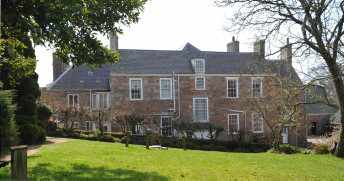In the second of a series of articles and talks over the year, staff at the Jersey Archive look at how Islanders can discover their roots. This week archivists Roland Quintaine and Linda Romeril look at the home of Durrell, Les Augrès Manor, and how you can research the history of your own house
IN 1958 Gerald Durrell first visited Les Augrès Manor in Trinity.
In his book ‘Menagerie Manor’ Gerald describes his first sight of the Jersey manor house that was to become the living embodiment of his dream of establishing a zoo: ‘…15th century arches, tidy lawns and flower-beds brimming over with colour. All the walls, buildings and outhouses were of beautiful Jersey granite which contains all the subtle colourings of a heap of autumn leaves…what a marvellous place for a zoo’.
In 1971 the Jersey Wildlife Preservation Trust purchased the property of Les Augrès Manor and 50 years after Gerald first rented the property, Durrell Wildlife Preservation Trust are continuing to follow his vision.
When Gerald visited Jersey he was actively looking for a place in which he could establish his own zoo. From his recollections in Menagerie Manor it would appear that he immediately fell in love with Les Augrès as a new home for his family and growing collection of animals.
Many of us will be able to empathise with Gerald’s feelings on seeing the manor and realising that this property was exactly the new home that he was looking for.
Buying a property in which to live and raise your family (or zoo) is a significant step in many people’s lives and the property you buy becomes more than just bricks and mortar – it is a place of memories, comfort and safety that becomes intrinsically linked with your life.
Recently the Jersey Archive has seen a growth in the number of researches trying to find out more about their properties and specifically the people and families that lived in their house in the past.
This article uses Les Augrès Manor as an example of how you can use records at the Jersey Archive to find out more about the history of your home and the people who lived there before you.
THE PUBLIC REGISTRY
The first place to search for evidence of previous owners of your property is the records of the Public Registry. The registry was established by Sir Walter Raleigh in 1602 when he was Governor of Jersey.
From this date all contracts should, by law, be recorded. The contracts concern the transfer of property from one individual to another and therefore contain vital information for house historians such as detailed descriptions of the land or piece of property involved in the transaction.
By searching through the computerised records of the Public Registry at the Jersey Archive we can find the 1971 contract which gives details of the purchase of the house called Les Augrès Manor by Jersey Wildlife Preservation Trust from Angus Hugh Fraser – the man who had first brought Gerald to Jersey and rented the manor to him.
The Public Registry contracts are incredibly useful for house historians as they include a list of the most recent previous owners of the property and give dates of when the property was brought and sold.
The 1971 Augrès Manor contract tells us that Angus Fraser inherited the property from his grandfather John Henry Pearson Fraser in 1949. Also listed is the previous sale of the property in 1926 when John Fraser purchased the manor and land from John Perchard.
To trace back the owners of the property even further we can look at the 1926 contract which shows that John Perchard inherited the manor as eldest son and principle heir of his father, also John in 1891.
So by looking at the public registry contracts we can see that the manor belonged to at least two generations of the Perchard family. We can then use the Public Registry to trace the history of Les Augrès even further back.
CENSUS RECORDS
The information in the Public Registry can be supplemented by census records. In 1871 we can see that John Perchard aged 22 (who left the manor to his son in 1891) was living at Les Augrès with his wife Caroline and son John. The family have one servant, Marguerite Mollet and John is described as a landowner of 25 acres.
Looking back ten years to the 1861 census, we can see that the Perchards had a large household with John junior living with his parents John Perchard senior, born in 1801, and his wife Thomazine Perchard. John senior is described as a landowner of 30 acres and the household includes one housemaid, a dairymaid, a house servant and a groom.
MAPS OF THE ISLAND
The 1849 Godfray map confirms that the Perchard Family were living at Les Augrès. The Godfray Map is a very useful tool for house historians as it shows individual houses (excluding heavily populated areas) and includes the name of the landowner.
Les Augrès also appears on the 1795 Duke of Richmond map. The Richmond map is the first really accurate survey of the Island commissioned by the Duke of Richmond in response to the threat of invasion by the French. Individual properties are shown on the map but names of landowners are not included.
John Perchard, born in 1801 in Trinity, was the son of Jean Perchard and Marie Gabourel of St Peter. Les Augrès was brought into the Perchard family through the Gabourel connection. Jean Perchard and Marie Gabourel, the daughter of Amice Gabourel, were married in 1794. Marie was one of Amice’s three daughters.
BANKRUPTCY RECORDS
By looking at bankruptcy records at the Jersey Archive we can see that Amice was appointed as one of the ‘tenants après décret’ of Elie Dumaresq by an Act of the Cour du Cattel in 1761.
As tenant, Amice took over all the real property of the individual who went bankrupt, which, in this case included Les Augrès Manor.
Elie Dumaresq’s bankruptcy case covers nearly 100 pages in the volumes at the Jersey Archive. Elie had inherited property including the manor and the title of Seigneur of the Fief des Augrès. The manor had been in the Dumaresq family since the mid 16th century. Interestingly, the manor is actually located on the Fief de Diélament not the Fief des Augrès.
The confusion between the manor’s location and its name arose when the Dumaresq family purchased the Fief des Augrès in the mid 17th century. The family continued to live at the manor and as they were now Seigneurs of the Fief des Augrès the manor became known as Les Augrès Manor.
The Seigneur’s title and the ownership of the manor were separated in 1771 when Elie Dumaresq sold the title to Nicolas Messervy.
CLUES AT THE PROPERTY
The information you find by looking through the records at Jersey Archive can be enhanced by looking at your property and trying to find clues of alterations to buildings and evidence of date stones.
Public Registry contracts can often be used to find out when a house is built but we have very few records of actual changes made to properties until Planning records begin in 1934.
Before this date, alterations to a house could be made without submitting plans or requesting permission so no official records of building works survive.
Les Augrès Manor has two significant date stones, one showing the initials of Jean Perchard and Marthe Le Feuvre, the other Elie Dumaresq and Elizabeth de Carteret.
These date stones confirm the Perchard and Dumaresq connections with the property that we have found by looking through the official records.
OTHER OFFICIAL RECORDS
There are many other records that can be used when tracing your house history. Just two examples are requisitioning papers from the Occupation and insurance registers which will show if your ancestors insured their houses against damage and fire.
lTo find about more about your house history visit the Jersey Archive on Saturday 21 March. The Archive is open from 9 am – 1 am with staff on hand to help with your house history. At 10 am Linda Romeril will give on talk on tracing your house history using Les Augrès Manor as an example. The talk will be introduced by Lee Durrell.
Why don’t you try…
• Searching for previous owners of your house in the Public Registry records at the Jersey Archive
• Looking at census records to find out more about the occupations and status of the previous owners of your property
• Searching the date stone register to see if your house appears
• Looking at maps and aerial photographs at the Jersey Archive
• Finding out if your house was requisitioned by the German authorities during the Occupationnextpage Les Augrès Manor in Trinity, the home of the Durrell Wildlife Preservation Trust. The granite property dates back to at least the 16th century, when it belonged to the Dumaresq familynextpage
Les Augrès Manor in Trinity, the home of the Durrell Wildlife Preservation Trust. The granite property dates back to at least the 16th century, when it belonged to the Dumaresq familynextpage Gerald Durrell, who thought Les Augrès Manor would be ‘a marvellous place for a zoo’nextpage
Gerald Durrell, who thought Les Augrès Manor would be ‘a marvellous place for a zoo’nextpage A document from the 1761 bankruptcy case of Elie Dumaresq
A document from the 1761 bankruptcy case of Elie Dumaresq






